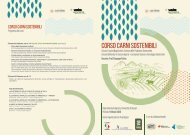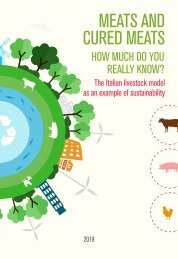Novel antibiotics effective against grampositive and -negative multi-resistant bacteria with limited resistance
Antibiotics are a medical wonder, but an increasing frequency of resistance among most human pathogens is rendering them ineffective. If this trend continues, the consequences for public health and for the general community could be catastrophic. The current clinical pipeline, however, is very limited and is dominated by derivatives of established classes, the “me too” compounds.
Antibiotics are a medical wonder, but an increasing frequency of resistance among most human pathogens is rendering them ineffective. If this trend continues, the consequences for public health and for the general community could be catastrophic. The current clinical pipeline, however, is very limited and is dominated by derivatives of established classes, the “me too” compounds.
Create successful ePaper yourself
Turn your PDF publications into a flip-book with our unique Google optimized e-Paper software.
<strong>Novel</strong> broad-spectrum <strong>antibiotics</strong> for combating <strong>multi</strong>drug <strong>resistance</strong><br />
stained <strong>with</strong> 3% uranyl acetate. Microscopy was performed <strong>with</strong> a 120-keV Zeiss 912 Omega<br />
(Oberkochen) microscope. To optimize the contrast, zero-loss energy filtering was applied.<br />
Resistance studies<br />
Vancomycin, polymyxin B, fosfomycin, rifampicin, <strong>and</strong> pseudopeptide MICs were determined<br />
forS.aureus Newman, MRSA,P.aeruginosa 15643, <strong>and</strong> LESB58, as well asE.coli K12 <strong>and</strong><br />
13090. For 15 d in MHB, MICs were determined daily for each pseudopeptide <strong>and</strong> their antibiotic<br />
controls. This was done using cells from the well in which the compound concentration<br />
was one-half of the MIC (1/2MIC). For each compound, the 1/2MIC well from the previous<br />
day’s MIC assay plate was re-suspended <strong>and</strong> the <strong>bacteria</strong> grown to a density of about 10 8 cells<br />
ml−1. The suspension was diluted in MHB or CAMHB (10 6 cells/ml) <strong>and</strong> then used to determine<br />
the MIC of the same compound determined by micro broth dilution [32]. All MIC measurements<br />
were performed in duplicate. Aliquots of the 5×10 4 cell/ml dilutions for each 1/<br />
2MIC well were periodically plated on MHB <strong>and</strong> incubated at 35˚C for 18 h to verify cell density<br />
by colony counts <strong>and</strong> for visual inspection of colony phenotypes. To control compound<br />
stability, peptide solution MICs were determined during <strong>and</strong> at the end of the 15 d <strong>and</strong> were<br />
compared to cells unexposed to <strong>antibiotics</strong>. In vivo <strong>resistance</strong> was also assessed in treated mice<br />
(1.5 mg.kg −1 ) for 4 d (sepsis) or 6 d (skin abscesses). The MICs of Pep16, Pep19, <strong>and</strong> vancomycin<br />
were determined for colonies observed on BHI plates after the homogenization of excised<br />
mice kidneys 4 d after inoculation (sepsis model) or of excised abscesses 6 d afterwards (skin<br />
infection model). The broth microdilution method was performed as per EUCAST recommendations<br />
on 5 independent colonies per mouse (3 mice per set, 15 colonies per drug tested).<br />
For severe sepsis <strong>and</strong> subcutaneous abscesses, in vivo <strong>resistance</strong> was determined by plating aliquots<br />
of crude kidney extracts or abscesses on plates containing 1-, 2-, 4-, or 8-fold the peptide<br />
MICs 7 or 3 d post infections, respectively.<br />
Animal efficacy studies<br />
Tolerance <strong>and</strong> toxicity studies were done on male Swiss mice (CD-1 Crl: CD-1 [ICR] IGS;<br />
Charles River). These were 7 to 10 weeks old <strong>and</strong> weighed an average of 37.2 g. All experimental<br />
protocols were approved by the Adaptive Therapeutics Animal Care <strong>and</strong> Use Committee<br />
(APAFiS #4508-2016031l15541258 v2). For the sepsis model, we used female Swiss mice (Janvier<br />
Labs), 6 to 8 weeks old <strong>and</strong> weighing approximately 30 g. Experiments were monitored in<br />
the ARCHE-BIOSIT animal lab in Rennes, in biological duplicate. We used Groups of 5 mice<br />
for the mild <strong>and</strong> the severe sepsis models <strong>with</strong> MRSA. Mice were IV inoculated <strong>with</strong> 150μl of<br />
MRSA suspensions in 0.9% NaCl containing approximately 5×10 8 CFUs for the “mild” sepsis<br />
<strong>and</strong> approximately 2×10 9 CFUs for the “severe” sepsis, respectively. The infected mice<br />
received an IV dose of Pep16, Pep19, or vancomycin (1.5 mg.kg −1 ) either 3 or 15 h post inoculation<br />
for the “mild” sepsis model, or 4 IV doses (0.5 mg.kg −1 ) of either Pep16, Pep19, brilacidin,<br />
or vancomycin 2 h, 24 h, 48 h, <strong>and</strong> 72 h post infections for the “severe” sepsis model. Mice<br />
survival was monitored for 4 d (“severe” sepsis) or 14 d (“mild” sepsis), <strong>and</strong> the statistical significance<br />
of difference(s) between the groups was evaluated using the Wilcoxon test.P


















